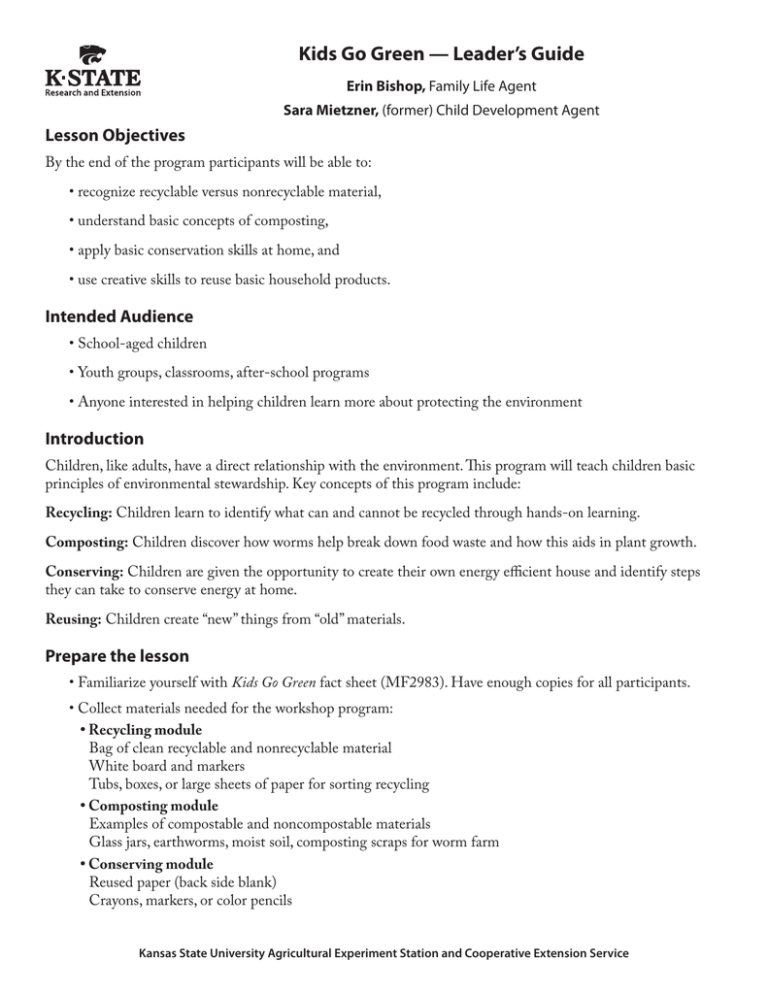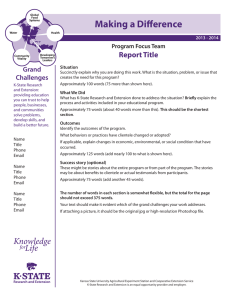
Kids Go Green — Leader’s Guide
Erin Bishop, Family Life Agent
Sara Mietzner, (former) Child Development Agent
Lesson Objectives
By the end of the program participants will be able to:
• recognize recyclable versus nonrecyclable material,
• understand basic concepts of composting,
• apply basic conservation skills at home, and
• use creative skills to reuse basic household products.
Intended Audience
• School-aged children
• Youth groups, classrooms, after-school programs
• Anyone interested in helping children learn more about protecting the environment
Introduction
Children, like adults, have a direct relationship with the environment. This program will teach children basic
principles of environmental stewardship. Key concepts of this program include:
Recycling: Children learn to identify what can and cannot be recycled through hands-on learning.
Composting: Children discover how worms help break down food waste and how this aids in plant growth.
Conserving: Children are given the opportunity to create their own energy efficient house and identify steps
they can take to conserve energy at home.
Reusing: Children create “new” things from “old” materials.
Prepare the lesson
• Familiarize yourself with Kids Go Green fact sheet (MF2983). Have enough copies for all participants.
• Collect materials needed for the workshop program:
• Recycling module
Bag of clean recyclable and nonrecyclable material
White board and markers
Tubs, boxes, or large sheets of paper for sorting recycling
• Composting module
Examples of compostable and noncompostable materials
Glass jars, earthworms, moist soil, composting scraps for worm farm
• Conserving module
Reused paper (back side blank)
Crayons, markers, or color pencils
Kansas State University Agricultural Experiment Station and Cooperative Extension Service
• Reusing module
Clean, empty milk jugs
Scissors, glue, and decorative items
Wire and wire cutter (for adults to use)
Birdseed
Lesson Information/Delivery Methods
You may want to ask the children questions before each module to gauge what they know about the topic.
Recycling Module
This module will help children understand the difference between waste and recyclable items. To familiarize
yourself with what can and cannot be recycled refer to Donna Krug’s (2009) It’s Easy to be Green fact sheet
(MF2886).
Activity
Review with children items that can be recycled. Show them specific examples of plastics #1 and #2 and
where to locate the plastic number on the product. Bring in examples of cardboard, chipboard, aluminum,
steel, batteries, paper, and glass. (Glass should only be handled by adult instructor.) Provide examples of items
that cannot be recycled, such as Styrofoam, plastics #3, #4, #5, and #6, synthetic fabrics, and other items.
Once children have a basic understanding of what can be recycled and the different types of products, have
them play a sorting game. Label different areas of the floor as “plastic #1 and #2,” “aluminum,” “cardboard,”
“paper,” and “trash.” Place all the “safe” recyclables and nonrecyclables in the middle of the floor. Have
children work as a group to sort the pile. Review each smaller pile/category with the group. If time allows,
the leader can pair up students and form teams. A stopwatch or clock can be used to time how quickly
and correctly each team sorts recyclable and nonrecyclable materials. Identify what was done correctly and
encourage children to recategorize any misplaced items.
Finally, encourage children to share what recycling steps they are taking at home.
Composting Module
This module will help children understand the process of composting and how worms aid in plant development
and growth. Familiarize yourself with KSU Horticultural Report (1992) Making and Using Compost at Home
(MF1053) and the directions to home composting in the Kids Go Green fact sheet.
Activity
Bring in specific examples of items that can be composted (plant materials, paper, etc.) and items that
cannot be composted (plastics, processed foods, and meat products). Review with children the basic
concepts of composting. Once children have grasped these concepts, give them the opportunity to
determine if an item is “worm-food friendly” or not.
Leader may also want to create a worm farm — directions found at Missouri Department of Natural
Resources website (link also found in references of Kids Go Green) — to show children. This hands-on
experience lets children see worms in action. Make sure the jar is clear, and encourage children to track
worm tunnels through the jar.
Conserving Module
This module will help children apply basic conservation skills to home efficiency. The emphasis on this module is
on reducing energy consumed in households.
Activity
Start this section by asking children What does conserving mean to you?” Once children have given their
own definitions, review conserving and reducing energy with them. Follow up by asking children what
steps they are taking in their homes.
Give each child a piece of reused paper and coloring utensils. Encourage the childrem to create their own
energy-efficient homes. Once they have finished this project, have volunteers share their houses with the
group, specifically highlighting ways their created home conserves energy. Review answers and inform
children of any further conservation skills they can use today (lights off, TV off, turn off water when
brushing teeth, unplug appliances).
Reusing Module
This module encourages children to use creative ideas to “make old: things new.” The emphasis is on reusing
household items that would otherwise be thrown out.
Activity
Cut an opening into the side of each clean, empty milk jug and have children make them into birdfeeders.
Encourage children to spend time decorating their milk jugs using craft items the leader has supplied.
Once the milk jugs have been decorated, attach wire to each lid or handle so they can be hung in trees.
Send home small bags (or clean, reused plastic containers) with birdfeed.
Ask children to brainstorm how reusing items helps the environment. Or ask, “What are some other items
you might be able to reuse?”
Evaluation
This evaluation will be based on leader’s interpretations of the workshop and children’s knowledge.
What prior knowledge did the children attending the program have?
In what activities did the children seem most interested?
What knowledge did children seem to gain from the program?
Overall, would the leader repeat this program with children again?
a. Definitely b. Maybe
c. Not at all
Resources
Brendler, C. (2009). Winnie Finn, Worm Farmer. Farrar Straus Giroux: New York.
Krug, D. (2009). It’s Easy to be Green, Fact Sheet (MF2886). K-State Research and Extension.
Pfeffer, W. (2004). Wiggling Worms at Work. Harper Collins: New York.
Marr, C. (1992). Making and Using Compost at Home (MF1053). KSU Horticulture Report. K-State Research
and Extension.
Missouri Department of Natural Resources: Division of Environmental Quality (2008). Quart Jar Worm Farm,
Pub2188. http://dnr.mo.gov/env/swmp/worms/wormjar.htm
Urban Programming Resource Network: University of Illinois Extension. (no date) Adventures of Herman the
Worm. h
Authors
Erin Bishop, Family Life Agent, K-State Research and Extension –
Fort Riley
Sara Mietzner, former Child Development Agent, K-State Research and Extension – Fort Riley
Reviewers
Karen Blakeslee, Extension Associate, Food Safety, K-State Research and Extension
Donna Krug, Family and Consumer Sciences Agent, K-State Research and Extension – Barton County
Brand names appearing in this publication are for product identification purposes only. No endorsement is intended,
nor is criticism implied of similar products not mentioned.
Publications from Kansas State University are available at: www.ksre.ksu.edu
Publications are reviewed or revised annually by appropriate faculty to reflect current research and practice.
Date shown is that of publication or last revision.
Contents of this publication may be freely reproduced for educational purposes. All other rights reserved.
In each case, credit Erin Bishop, et al, Kids Go Green, Leader’s Guide,
Kansas State University, July 2011.
Kansas State University Agricultural Experiment Station and Cooperative Extension Service
MF2984
July 2011
K-State Research and Extension is an equal opportunity provider and employer. Issued in furtherance of Cooperative Extension Work, Acts of May 8 and June 30, 1914,
as amended. Kansas State University, County Extension Councils, Extension Districts, and United States Department of Agriculture Cooperating, Gary Pierzynski, Interim
Director.

